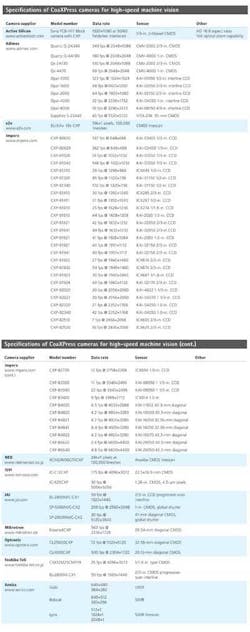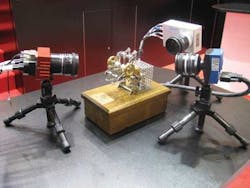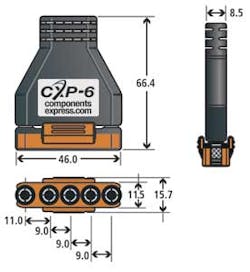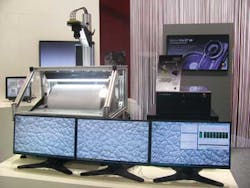HIGH-SPEED INTERFACE STANDARDS: CoaXPress interface standard adopted by camera vendors at VISION show
Anyone who doubted that the CoaXPress (CXP) standard would become the next-generation high-speed camera interface would have their fears alleviated at last November's VISION trade show in Stuttgart, Germany. There, more than ten manufacturers showed a range of high-resolution, high-speed linescan and area-array CMOS and CCD cameras developed specifically for high-speed machine-vision applications (to see a listing of the CXP products that debuted at VISION 2012, view our table below).
However, the choice of which standard would be most prominent was, for a number of years, very doubtful with Teledyne DALSA promoting the Camera Link HS standard and the CoaXPress consortium (www.coaxpress.com) taking a different design approach. Indeed, the somewhat confusing messages sent to the marketplace about which standard might eventually dominate has been duly noted by Jochem Herrmann, chief scientist at Adimec.
At VISION 2012, Herrmann said that to stop such a standards battle from appearing again, the European Machine Vision Association (EMVA; www.emva.org), Automated Imaging Association (AIA; www.visiononline.org), and Japan Industrial Imaging Association (JIIA; www.jiia.org) have created a Future Standards Forum (FSF) to investigate opportunities offered by new technologies, identify future challenges, and provide recommendations for new standards and the evolution of existing standards. Additionally, the FSF aims to promote the re-use of elements within existing standards to minimize overlap between standards and prevent the duplication of work. This will certainly be a benefit both for those developing cameras and those that require a roadmap of how future standards will emerge.
To highlight the cabling differences between traditional high-speed Camera Link and CXP standards, Active Silicon demonstrated a number of different cameras on its booth at the VISION 2012 show, all with different cabling interfaces (see Fig. 1).
To attain a 386 frames/sec data rate in its 2320 × 1726-pixel CMOS-based Bonito camera (red), for example, Allied Vision Technologies (AVT) employs a dual Deca 10-tap Camera Link Full+ interface that requires four MDR 26-pin camera cables and a single power cable.
In contrast, the EoSens4CXP camera from Mikrotron shown in blue is a 2336 × 1728-pixel CMOS-based camera running at 563 frames/sec with a single D-type 5W5 connector that transfers data to the host PC using the CXP standard. In the implementation shown in Fig. 1, the four coaxial cables within the single D-type 5W5 connector were then broken out to four standard BNC connectors and interfaced to Active Silicon's FireBird CXP frame grabber. The 5W5 connector was an early frontrunner for a multiway connector, but this has been superseded by the DIN 1.0/2.3 connector, originally proposed by Cambridge Connectors (www.cambridgeconnectors.com) and since developed by Components Express Inc. (CEI) to demonstrate practical multiway solutions.
Also using the CXP interface, the Optronis CL25000CXP from Optronis, a 5120 × 5120-pixel CMOS-based camera (shown in white) running at 72 frames/sec was exhibited as interfaced to a FireBird CXP frame grabber with four separate DIN 1.0/2.3 connectors. The use of the DIN 1.0/2.3 is in the draft v1.1 CoaXPress specification and is likely to become part of the standard early in 2013.
According to Ray Berst, president of CEI, the draft proposal provides multiple and single DIN 1.0/2.3 connectors in a single housing. The downlink lanes are 9 mm apart and the high-speed uplink lane is 11 apart (see Fig. 2). This unique mechanism allows for positive locking of all DIN 1.0/2.3 lanes and a simple pull-type unlatch mechanism.
CEI is now producing these cables with a traditional BNC connector on the opposite end of the cable, making the 75-Ω BNC compatible with the new DIN 1.0/2.3 connection. Since the DIN 1.0/2.3 is a true 75-Ω connector with higher bandwidth capability than the BNC connector, the DIN connector will allow future speed of 10.0 and 12.5 Gbits/sec while the BNC will not.
To demonstrate the capability of CXP-based components in high-speed web inspection systems, Matrox Imaging demonstrated the ELiiXA+ 16k four-link CXP 16k × 1-pixel linescan camera from e2v performing high-speed surface inspection at VISION 2012 (see Fig. 3). With a simulated web speed of approximately 4 m/sec, the linescan camera transferred images to a host PC using Matrox's Radient eV-CXP frame grabber board housed in a Matrox Supersight imaging computer. By partitioning image-processing tasks between a multicore CPU and a GPU, the system was shown capturing defects as small as 70 µm at the full 4 m/sec web speed.




